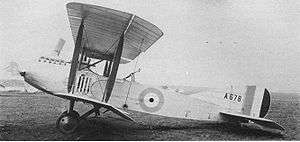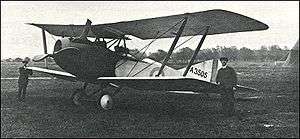Vickers F.B.14
| Vickers F.B.14 | |
|---|---|
 | |
| Role | Fighter, reconnaissance biplane |
| National origin | United Kingdom |
| Manufacturer | Vickers |
| First flight | 1916 |
| Primary user | Royal Flying Corps |
| Number built | 100+ |
|
| |

The Vickers F.B.14 was a British two-seat fighter/reconnaissance biplane designed and built by Vickers Limited. About 100 were built for the Royal Flying Corps but saw only limited use as it was designed for a larger engine which was not available when production commenced and it did not meet performance expectations.
Design and development
The F.B.14 was a conventional single-bay biplane with two tandem open cockpits and a fixed tailskid landing gear. It was designed to use a new engine, the 230 hp (170 kW) BHP inline engine (later to become the Siddeley Puma). The steel-tube airframe was completed in mid-1916, but the engine was not ready and it was fitted with a 160 hp (120 kW) Beardmore engine instead.[1] The aircraft was underpowered with the Beardmore engine and suffered reliability problems and over 50 production aircraft were delivered to the Royal Flying Corps without engines. A more reliable engine was tested, but the 120 hp (90 kW) Beardmore did not help meet the performance required. Attempts to fit alternate engines resulted in a number of variants with the most successful being a Rolls-Royce Eagle IV Vee engine. The aircraft performance was inferior to the contemporary Bristol F.2B, however, and further development of the F.B.14 was abandoned.
The F.B.14 saw limited operational use, with some being sent to Mesopotamia, with seven being used in home defence squadrons. The Rolls-Royce powered F.B.14D, while being used for testing of an experimental gunsight at Orfordness on 22 July 1917, engaged in a German air raid and claimed an unconfirmed shoot-down of a Gotha bomber off Zeebrugge.[2][nb 1]
Variants
- F.B.14
- Production aircraft powered by a 160 hp (120 kW) Beardmore engine, 104 built by Vickers at Weybridge.
- F.B.14A
- Re-engined with a 150 hp (110 kW) Lorraine-Dietrich Vee engine, one built.
- F.B.14D
- Re-engined with a 250 hp (190 kW) Rolls-Royce Eagle IV engine and fitted with increased span two-bay wings.[2]
- F.B.14F
- Re-engined with a 150 hp (112 kW) RAF 4a air-cooled V-12 engine.
Operators
Specifications (F.B.14)
Data from Vickers Aircraft since 1908 [4]
General characteristics
- Crew: 2
- Length: 28 ft 5 in (8.66 m)
- Wingspan: 39 ft 6 in (12.04 m)
- Height: 10 ft 0 in (3.05 m)
- Wing area: 427 ft2 (39.7 m2)
- Empty weight: 1662 lb (755 kg)
- Gross weight: 2603 lb (1183 kg)
- Powerplant: 1 × Beardmore engine, 160 hp (119 kW)
Performance
- Maximum speed: 99.5 mph ( km/h)
- Endurance: 3 hours 45 min
- Service ceiling: 10,000 ft (3,050 m)
Armament
- 1 × forward-firing .303 in (7.7 mm) Vickers machine gun
- 1 × .303 in (7.7 mm) Lewis Gun fitted on a Scarff ring in rear cockpit
See also
- Related lists
References
- ↑ While one Gotha was shot down just off Ostend on 22 July, it is likely that this was due to a Bristol F.2B Fighter of No. 48 Squadron RFC.[3]
- Andrews, C.F.; Morgan, E.B. (1988). Vickers Aircraft since 1908 (Second ed.). London: Putnam. ISBN 0-85177-815-1.
- Cole, Christopher; Cheesman, E.F. (1984). The Air Defence of Great Britain 1914–1918. London: Putnam. ISBN 0-370-30538-8.
- Taylor, Michael J. H. (1989). Jane's Encyclopedia of Aviation. London: Studio Editions.
- The Illustrated Encyclopedia of Aircraft (Part Work 1982-1985). Orbis Publishing.
External links
| Wikimedia Commons has media related to Vickers F.B.14. |